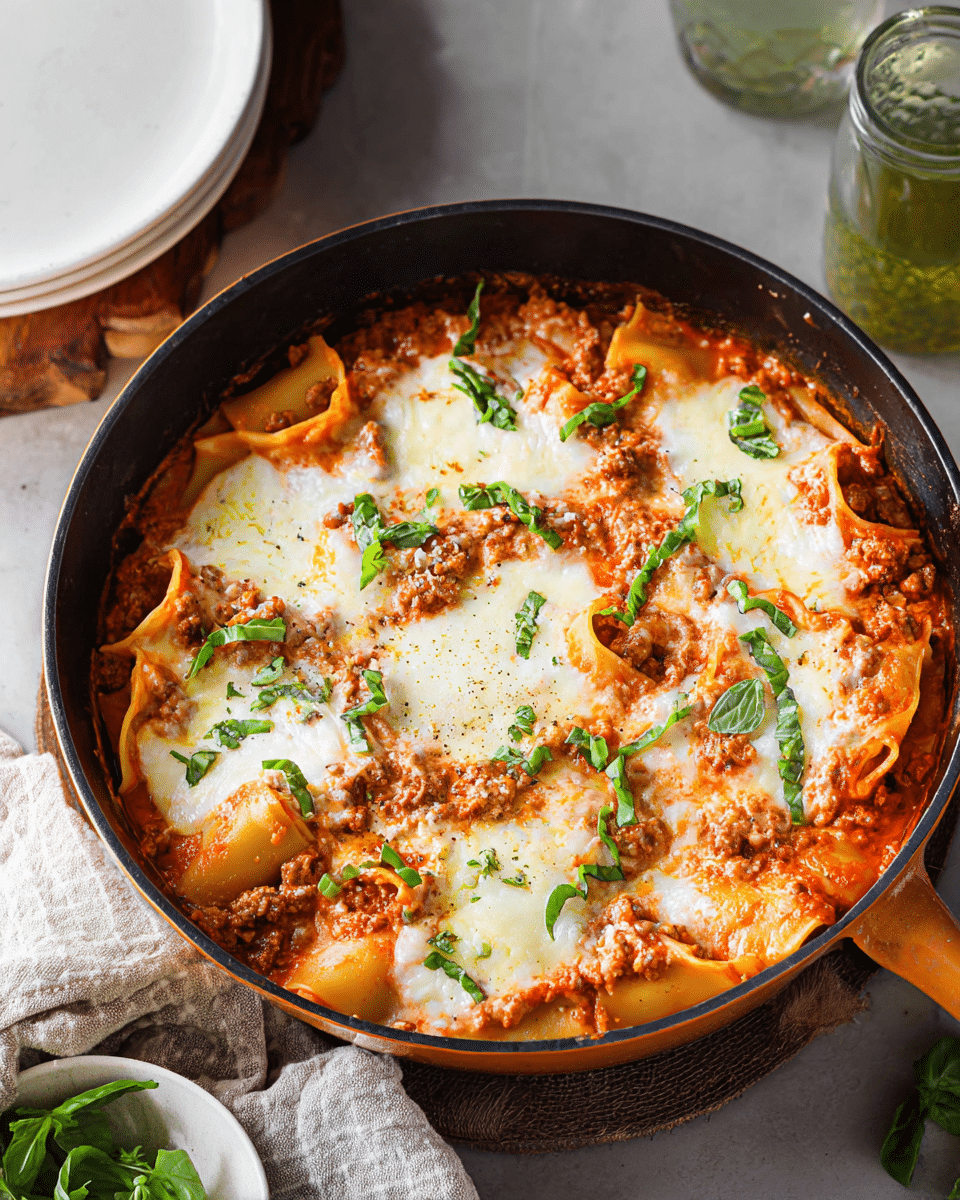This skillet lasagna is a savory, comforting dish packed with all the cheesy goodness you expect from classic lasagna, but with the ease of a one-pan meal. Perfectly cooked noodles, rich marinara sauce, and a blend of melted mozzarella and ricotta come together to create a dinner that is sure to impress. The layers of flavor will make it a new favorite in your household.
This dish is not only quick and easy to make but also customizable! You can swap out ground beef for ground turkey or even make it vegetarian by adding sautéed vegetables instead of meat. It’s ideal for busy weeknights but is so delicious it could easily become a go-to for special occasions, too.
Full Recipe:
-
1 lb ground beef
-
1 onion, chopped
-
2 cloves garlic, minced
-
1 (24 oz) jar marinara sauce
-
1 (15 oz) container ricotta cheese
-
2 cups shredded mozzarella cheese
-
1/2 cup grated Parmesan cheese
-
12 oz uncooked lasagna noodles, broken into pieces
-
2 cups water
-
2 teaspoons dried oregano
-
1 teaspoon dried basil
-
Salt and pepper, to taste
Directions:
-
Heat a large skillet over medium heat and brown the ground beef with the onion and garlic until the beef is no longer pink, about 7 minutes. Drain any excess fat.
-
Stir in the marinara sauce, ricotta cheese, 1 cup mozzarella, Parmesan cheese, oregano, basil, and a pinch of salt and pepper. Bring to a simmer.
-
Add the broken lasagna noodles and water to the skillet, stirring to combine. Bring the mixture to a boil.
-
Reduce the heat, cover the skillet, and simmer for 20-25 minutes, or until the noodles are cooked through and tender.
-
Sprinkle the remaining mozzarella on top and cover until the cheese has melted, about 2-3 minutes.
-
Garnish with fresh basil, slice, and serve.
Prep Time: 10 minutes | Cooking Time: 30 minutes | Total Time: 40 minutes
Kcal: 520 kcal | Servings: 4 servings
History and Origin
Lasagna, one of the most iconic dishes of Italian cuisine, has a history that spans centuries. While the origins of lasagna are debated, the earliest recorded recipe dates back to Ancient Greece, where a dish called “Laganon” was made from layers of pasta dough and sauces. The Romans adapted this idea, using sheets of pasta and sauces, much like lasagna today. It wasn’t until the 14th century in Italy that the dish began to take the form we recognize today, with pasta layered with cheese, meat, and sauces.
Skillet lasagna, on the other hand, is a more recent innovation. Its origin stems from the desire for a quicker, simpler method to prepare lasagna without sacrificing flavor or texture. The skillet version typically involves using broken pieces of lasagna noodles, which allows for a quicker cooking time compared to the traditional whole sheets of pasta used in baked lasagna. This method was born out of convenience and necessity, making it an ideal solution for busy home cooks who crave the comfort of lasagna without the time commitment of the oven.
Variations and Adaptations
The beauty of skillet lasagna is its versatility. While the traditional version calls for beef, marinara sauce, and cheeses like ricotta and mozzarella, you can easily adapt it to suit different tastes or dietary preferences. For a lighter variation, try swapping out the ground beef for ground turkey or chicken, or even go vegetarian by using a mixture of sautéed vegetables such as mushrooms, zucchini, and bell peppers. Some variations also include a touch of cream cheese or sour cream for added richness.
Another popular variation is adding different cheeses, such as provolone, gouda, or Parmesan, to give the dish more depth of flavor. For a spicy kick, consider adding crushed red pepper flakes or some Italian sausage to the mix. You can also experiment with different herbs and spices, like fresh basil, thyme, or rosemary, to give the dish a unique twist that reflects your personal preferences.
Regional adaptations can also be seen in different parts of the world. In Southern Italy, where lasagna originated, the dish may feature a meat sauce made with pork or lamb instead of beef. In the United States, some versions of lasagna even feature a white sauce or béchamel instead of the traditional marinara, leading to an entirely different flavor profile.
Nutritional Information
Skillet lasagna, while comforting and delicious, can also be a relatively balanced meal. A serving typically provides a healthy dose of protein from the ground meat and cheeses, as well as carbohydrates from the lasagna noodles. Here’s a breakdown of the nutritional value for one serving of a traditional skillet lasagna:
-
Calories: Approximately 520 kcal
-
Protein: 35 grams
-
Carbohydrates: 40 grams
-
Fat: 25 grams
-
Fiber: 3 grams
-
Sodium: 900 mg
While this dish can be rich due to the cheese and meat, there are ways to modify it to make it lighter if you’re watching your caloric intake. For instance, opting for low-fat ricotta and mozzarella can reduce the overall fat content. Additionally, using ground turkey or chicken instead of beef can lower the calorie and fat count while still providing plenty of protein. If you’re following a gluten-free diet, simply substitute the lasagna noodles with gluten-free pasta or zucchini noodles for a lighter, low-carb version.
The meal also provides several key vitamins and minerals, including calcium from the cheeses, iron from the meat, and fiber from the vegetables you may choose to add. For an extra nutritional boost, you can toss in spinach or kale for additional vitamins A and K, or swap the ground meat for plant-based protein sources for a vegan option.
Serving Suggestions and Pairings
Skillet lasagna is a hearty, all-in-one meal, but it pairs wonderfully with a variety of side dishes to round out your meal. For a refreshing contrast to the richness of the lasagna, a simple side salad with mixed greens, cherry tomatoes, and a light balsamic vinaigrette is an excellent choice. The fresh, crisp vegetables provide a nice balance to the warm, cheesy lasagna.
Garlic bread or crusty baguette slices are also great companions to help soak up any extra sauce. If you’re craving something with a little more indulgence, try pairing your skillet lasagna with a side of roasted vegetables or sautéed spinach to add extra flavor and nutrition to your plate.
To drink, a medium-bodied red wine such as Chianti, Merlot, or Cabernet Sauvignon works well with the savory and rich flavors of the lasagna. If you’re serving this meal to a crowd, consider a light Italian sparkling wine like Prosecco, which can cut through the richness of the dish and add a festive touch.
For a more casual and family-friendly experience, serve the skillet lasagna with some fresh fruit for dessert, like a berry medley or a classic Italian sorbetto to cleanse the palate after such a hearty meal.
Tips and Tricks for Success
To make sure your skillet lasagna turns out perfectly, there are a few helpful tips and tricks to keep in mind:
-
Use a heavy skillet: A large, heavy-bottomed skillet ensures that the heat is evenly distributed, so the noodles cook uniformly, and the sauce doesn’t burn.
-
Broken noodles work better: Breaking the lasagna noodles into smaller pieces allows them to cook faster and soak up the flavors of the sauce more efficiently. It also makes for a more rustic, comforting presentation.
-
Layering is key: Don’t be afraid to layer the ingredients. This ensures that the flavors are evenly distributed and that every bite has a good balance of noodles, sauce, and cheese.
-
Don’t overcook the noodles: Since the lasagna is cooked in a skillet, it’s important not to overcook the noodles before adding them to the skillet. They will continue to cook while absorbing the sauce, so make sure they’re still slightly firm when you add them.
-
Cover the skillet while cooking: For the best results, cover your skillet while it simmers. This helps to trap the heat and moisture, ensuring that the noodles soften without becoming dry.
Potential Health Benefits
Lasagna, particularly in its skillet form, offers several health benefits thanks to its combination of protein, fiber, and nutrient-rich ingredients. The ground beef (or turkey) provides a significant amount of protein, which is essential for muscle repair and growth. The cheeses, while rich in fat, also provide a good amount of calcium, which is vital for bone health.
For those looking to boost the nutritional profile of their lasagna, adding spinach or other leafy greens can increase the fiber content and provide a boost of vitamins A and K. The tomato sauce is a great source of antioxidants, particularly lycopene, which is believed to support heart health and protect against certain types of cancer.
Advertisement
Moreover, by using whole-wheat or gluten-free noodles, you can increase the fiber content of the dish, which aids in digestion and helps maintain steady blood sugar levels.
Conclusion
Skillet lasagna is a versatile, comforting, and easy-to-make dish that brings all the classic flavors of traditional lasagna into a one-pan, hassle-free meal. Whether you’re making it for a weeknight dinner, a family gathering, or a cozy night in, this recipe is sure to satisfy your cravings. With endless possibilities for customization, you can tailor it to suit your dietary preferences or the ingredients you have on hand.
So why not give this skillet lasagna a try? It’s an incredibly satisfying meal that’s as delicious as it is easy to make—and we promise it will become a staple in your cooking rotation. Whether you’re a busy parent, a home cook looking for a simpler take on lasagna, or someone in need of a comforting dish, this skillet version will not disappoint.






